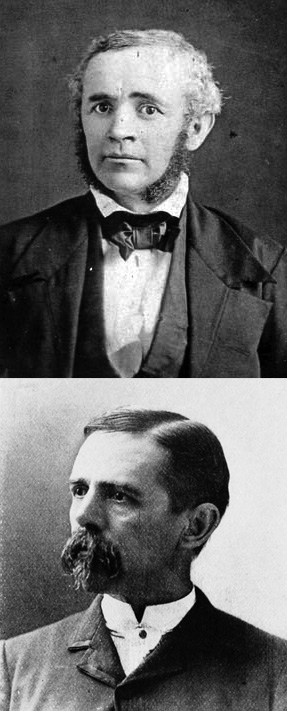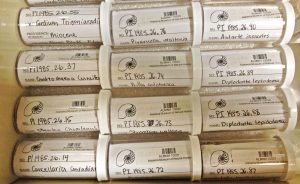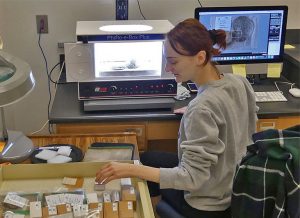History
The first fossils in the University of Alabama collection (fossil nuts from Madison County, Alabama) were reported by William MacMillan in 1831. Later, Irish geologist Michael Tuomey (1805–1857), professor at the University of Alabama since 1847 and the first state geologist since 1848, was the first person to assemble a sizeable collection consisting of hundreds of fossil species. The burning of the campus on April the 4th of 1865 during the Civil War included buildings in which fossils were reportedly stored, such as the Rotunda, Lyceum, and another building near the Lyceum. This event meant an enormous, irreplaceable loss for the natural heritage of Alabama. However, a part of Tuomey’s fossils stored in the Rotunda survived the war and are retained to the present day. According to some, Eugene Allen Smith (1841–1927) played a role in saving the remaining fossils, but he can certainly be credited for rebuilding the fossil collection. Smith became a professor at the University of Alabama in 1871 and the second state geologist in 1873. During the late 19th and early to mid-20th century, Smith, J. Anderson, Truman H. Aldrich, Herbert H. Smith, Daisy Smith, Walter B. Jones, and others expanded the fossil collection of the Alabama Museum of Natural History, which became established as an adjunct to the Geological Survey in 1910.
In 1961, the Alabama Museum of Natural History and the Geological Survey of Alabama separated, with the former becoming more officially linked to the University of Alabama. The fossil collection was divided between the two institutions subsequently. In the following decades, the collection of the Alabama Museum of Natural History was further expanded and curated by UA employees such as (in alphabetical order) Dana Ehret, Douglas E. Jones, John Hall, Brown Hawkins, Ed Hooks, James Lamb, James Parham, Mark Uhen, and others. Additionally, the generous donations of many fossils by avocational paleontologists such as (in alphabetical order) Prescott Atkinson, Ron Buta, Caleb Curren, David Leuth, George Martin, and many others, also contributed greatly to the collection’s growth. In 2005, the vertebrate fossils and Pennsylvanian trace fossils from Alabama’s Union Chapel Mine were transferred from the Geological Survey of Alabama to the Alabama Museum of Natural History. Another major change happened in 2016, when the UA Museum’s Department of Museum Research and Collections was created. The fossil collection has since been under the supervision of this department instead of the Alabama Museum of Natural History, but the Museum’s affiliation continues with the usage of ALMNH museum numbers for specimens, exhibition, and outreach uses of the collections.
Collection Summary and Highlights
The fossil collection is housed on the 3rd floor of Mary Harmon Bryant Hall on the University of Alabama campus and consists of well over 500,000 macrofossil specimens. The majority of these specimens are invertebrate fossils, but major vertebrate fossil collections are also present. Trace fossils such as footprints are also an important part of the collection (> 1500 specimens) and fossil plants comprise a small part of the collection (~700 specimens). The collection is mostly organized into these four groups. Geographically, most specimens (> 85%) originate from Alabama including Harrell Station, whereas the remaining fossils originate from other US states, mostly Florida, and other countries. Fossils range in age from ~500 million years ago (Cambrian Period) to nearly the present day.
Most of the collection is a research collection, but small parts are designated as teaching and type collections. The majority of the vertebrate, plant, and trace fossils have been catalogued and can be found in the online database Arctos. Conversely, the invertebrate fossils are largely uncatalogued; those that are will be uploaded into Arctos in the future.
Some of the highlights of the fossil collection:
- One of the largest collections of mosasaurs in the world.
- Abundant shark, fish, and turtle fossils, primarily from the Late Cretaceous.
- Important collections of Pennsylvanian footprints and plants.
- Extensive collections of Late Cretaceous and Cenozoic invertebrate fossils, mostly mollusks, from Alabama and some from Florida.
Type Specimens
The scientifically most important specimens of a collection are type specimens. These are specimens based on which new species have been described. As of November 2023, the paleontology collection houses 44 valid type specimens, including 27 holotypes, 1 lectotype, 2 syntypes, and 14 paratypes (see table below). Nearly all types originate from Alabama. The type specimens are stored in a dedicated cabinet in a separate room within the collection space.
Type specimens in the fossil collection arranged by the year the species was described. Download an Excel version of the table.
| Specimen number | Sort of type | Year described | Species name | Common name | Rock unit | Age | Location |
|---|---|---|---|---|---|---|---|
| ALMNH:Paleo:1 | holotype | 1930 | Hydromeda fimbriata Aldrich in Aldrich & Jones, 1930 | track | Pottsville Formation | Pennsylvanian (Bashkirian) | Walker County, Alabama |
| ALMNH:Paleo:4 | holotype | 1930 | Ctenerpeton primum Aldrich in Aldrich & Jones, 1930 | track | Pottsville Formation | Pennsylvanian (Bashkirian) | Walker County, Alabama |
| ALMNH:Paleo:5 | holotype | 1930 | Limnosaurus alabamaensis Aldrich in Aldrich & Jones, 1930 | track | Pottsville Formation | Pennsylvanian (Bashkirian) | Walker County, Alabama |
| ALMNH:Paleo:6 | holotype | 1930 | Kouphichnium aspodon (Aldrich in Aldrich & Jones, 1930) | track | Pottsville Formation | Pennsylvanian (Bashkirian) | Walker County, Alabama |
| ALMNH:Paleo:7 | holotype | 1930 | Quadropedia prima Aldrich in Aldrich & Jones, 1930 | track | Pottsville Formation | Pennsylvanian (Bashkirian) | Walker County, Alabama |
| ALMNH:Paleo:9 | syntype | 1930 | Cincosaurus jonesii Aldrich in Aldrich & Jones, 1930 | track | Pottsville Formation | Pennsylvanian (Bashkirian) | Walker County, Alabama |
| ALMNH:Paleo:25 | syntype | 1930 | Cincosaurus jonesii Aldrich in Aldrich & Jones, 1930 | track | Pottsville Formation | Pennsylvanian (Bashkirian) | Walker County, Alabama |
| ALMNH:Paleo:18 | lectotype | 1930 | Attenosaurus subulensis Aldrich in Aldrich & Jones, 1930 | track | Pottsville Formation | Pennsylvanian (Bashkirian) | Walker County, Alabama |
| ALMNH:Paleo:26 | holotype | 1930 | Trisaurus secundus Aldrich in Aldrich & Jones, 1930 | track | Pottsville Formation | Pennsylvanian (Bashkirian) | Walker County, Alabama |
| ALMNH:Paleo:27 | holotype | 1930 | Cincosaurus cobbi Aldrich in Aldrich & Jones, 1930 | track | Pottsville Formation | Pennsylvanian (Bashkirian) | Walker County, Alabama |
| ALMNH:Paleo:5521 | holotype | 1970 | Hadrodus hewletti (Applegate, 1970) | fish | Mooreville Chalk Formation | Cretaceous (early Campanian) | Greene County, Alabama |
| ALMNH:Paleo:5402 | holotype | 1975 | Clidastes “moorevillensis” Shannon, 1975 | mosasaur | Mooreville Chalk Formation | Cretaceous (early Campanian) | Greene County, Alabama |
| ALMNH:Paleo:5601 | holotype | 1976 | Cyrilavis olsoni (Feduccia & Martin, 1976) | bird | Green River Formation | early Eocene | Lincoln County, Wyoming |
| ALMNH:Paleo:5405 | holotype | 1988 | Selmasaurus russelli Wright & Shannon, 1988 | mosasaur | ?Mooreville Chalk Formation | Cretaceous (early Campanian) | western Alabama |
| ALMNH:Paleo:4495 | holotype | 2002 | Halimornis thompsonii Chiappe et al., 2002 | bird | Mooreville Chalk Formation | Cretaceous (early Campanian) | Greene County, Alabama |
| ALMNH:Paleo:6017 | holotype | 2005 | Nanopus reidiae Haubold et al., 2005 | track | Pottsville Formation | Pennsylvanian (Bashkirian) | Walker County, Alabama |
| ALMNH:Paleo:20178 | paratype | 2005 | Nanopus reidiae Haubold et al., 2005 | track | Pottsville Formation | Pennsylvanian (Bashkirian) | Walker County, Alabama |
| ALMNH:Paleo:13013 | holotype | 2005 | Arenicolites longistriatus Rindsberg & Kopaska-Merkel, 2005 | burrow | Pottsville Formation | Pennsylvanian (Bashkirian) | Walker County, Alabama |
| ALMNH:Paleo:13122 | holotype | 2005 | Treptichnus apsorum Rindsberg & Kopaska-Merkel, 2005 | burrow | Pottsville Formation | Pennsylvanian (Bashkirian) | Walker County, Alabama |
| ALMNH:Paleo:12641 | holotype | 2011 | Oligotypus tuscaloosae Beckemeyer & Engel, 2011 | insect | Pottsville Formation | Pennsylvanian (Bashkirian) | Tuscaloosa County, Alabama |
| ALMNH:Paleo:12929 | holotype | 2011 | Pharciphyzelus lacefieldi Beckemeyer & Engel, 2011 | insect | Pottsville Formation | Pennsylvanian (Bashkirian) | Walker County, Alabama |
| ALMNH:Paleo:13197 | holotype | 2011 | Anniedarwinia alabamensis Beckemeyer & Engel, 2011 | insect | Pottsville Formation | Pennsylvanian (Bashkirian) | Walker County, Alabama |
| ALMNH:Paleo:13232 | holotype | 2011 | Agaeoleptoptera uniotempla Beckemeyer & Engel, 2011 | insect | Pottsville Formation | Pennsylvanian (Bashkirian) | Walker County, Alabama |
| ALMNH:Paleo:3322 ALMNH:Paleo:6306 | paratypes | 2018 | Cretalamna bryanti Ebersole and Ehret, 2018 | shark | Mooreville Chalk Formation | Cretaceous (early Campanian) | Dallas County, Alabama |
| ALMNH:Paleo:6191 | holotype | 2018 | Peritresius martini Gentry et al., 2018 | turtle | Lower Ripley Formation | Cretaceous (late Campanian) | Lowndes County, Alabama |
| ALMNH:Paleo:9392 | holotype | 2018 | Arcuodus multicuspidatus Itano & Lambert, 2018 | fish | Bangor Limestone | Mississippian (early Serpukhovian) | Franklin County, Alabama |
| ALMNH:Paleo:13593 | holotype | 2018 | Archaemegaptilus blakelyi Beckemeyer & Engel, 2018 | insect | Pottsville Formation | Pennsylvanian (Bashkirian) | Bibb County, Alabama |
| ALMNH:Paleo:2792 | holotype | 2020 | Cretasquatina americana Maisey et al., 2020 | shark | Mooreville Chalk Formation | Cretaceous (early Campanian) | Dallas County, Alabama |
| ALMNH:Paleo:670 | holotype | 2022 | Appalachemys ebersolei Gentry et al., 2022 | turtle | Mooreville Chalk Formation | Cretaceous (late Santonian-early Campanian) | Alabama |
| ALMNH:Paleo:20325 | holotype | 2022 | Heterocyathus filkorni Videira-Santos et al., 2022 | coral | Santa Marta Formation | Cretaceous (late Santonian-early Campanian) | James Ross Island, Antarctica |
| ALMNH:Paleo:20303-20305, 20312-20316, 20326-20328 | paratypes | 2022 | Heterocyathus filkorni Videira-Santos et al., 2022 | coral | Santa Marta Formation | Cretaceous (late Santonian-early Campanian) | James Ross Island, Antarctica |
| ALMNH:Paleo:20409 | holotype | 2023 | Cavusodus whitei Itano, 2023 | shark | Bangor Limestone | Mississippian (early Serpukhovian) | Franklin County, Alabama |
| ALMNH:Paleo:5452 | holotype | 2023 | Ectenosaurus shannoni Kiernan & Ebersole, 2023 | mosasaur | Mooreville Chalk | Cretaceous (early Campanian) | Greene County, Alabama |
Uses of the Collection
First and foremost, the collection has been and is being actively used for scientific research. Scientists, students, and avocational paleontologists from Alabama, elsewhere in the US, and around the world regularly visit our collections to study fossils. Specimens are also loaned to researchers. Every year, paleontologists who have studied fossils in our collection publish multiple scientific articles on that material. Staff, student interns, and volunteers work together to curate specimens as new material gets accessioned and when existing collections get cataloged, digitized, and/or rehoused. Particularly striking or characteristic fossils have been and are being used for permanent and temporary exhibits at the Alabama Museum of Natural History and elsewhere on campus. Finally, fossils of our collection are utilized for classes, as part of public and online outreach events, and during tours of the entire UA Museums collection or the paleontology collection specifically.
People and Other Information
- Dr. Adiel A. Klompmaker, Curator of Paleontology
- Brooke Bogan, Collections Manager of Natural History
- Dr. Harry “Bing” Blewitt, Research Associate and long-term volunteer
- Students and other volunteers
Feel free to contact the curator if you would like to become a volunteer or intern of the paleontology collection to help curate the collection, learn more about fossils, and acquire multiple new skills.
The paleontology collections are supported by the Paleontology Collection Enhancement Fund. Feel free to check it out for tax-deductible donations.
References History Part
Internal notes and reports, Department of Museum Research and Collections & Alabama Museum of Natural History, including MacMillan (1831).
Ebersole, J. A. & Dean, L. S. 2013. The history of Late Cretaceous vertebrate research in Alabama. Bulletin of the Alabama Museum of Natural History, 31, 3–45.
Wilson, B. M. 1985. The Geological Survey of Alabama and the University of Alabama: A coordinate history. Earth Sciences History, 4, 59–62.


